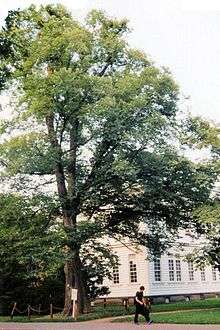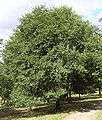Ulmus davidiana var. japonica
| Ulmus davidiana var. japonica | |
|---|---|
 | |
| Japanese elm, Sapporo | |
| Scientific classification | |
| Kingdom: | Plantae |
| (unranked): | Angiosperms |
| (unranked): | Eudicots |
| (unranked): | Rosids |
| Order: | Rosales |
| Family: | Ulmaceae |
| Genus: | Ulmus |
| Species: | U. davidiana |
| Trinomial name | |
| Ulmus davidiana var. japonica Rehder | |
| Synonyms | |
| |
Ulmus davidiana var. japonica, the Japanese elm, is one of the larger and more graceful Asiatic elms, endemic to much of continental north-east Asia and Japan, where it grows in swamp forest on young alluvial soils, although much of this habitat has now been lost to intensive rice cultivation.[1]
Description
The size and shape of the Japanese elm is extremely variable, ranging from short and bearing a densely branched broad crown similar to the Wych elm[2] to tall, single-stemmed, with narrow crown similar to the English elm[3][4] Augustine Henry described one of the latter outside Iwamigawa, Hokkaido, railway station as being 34 m tall, with a clean stem to a height of approximately 15 m. [5] The young shoots often bear corky wings, similar to those of the European field elm U. minor, to which it is closely related. The leaves are generally obovate, < 11 cm long, and with a coarse upper surface. Like many of the European field elms, var. japonica retains its green foliage well into the autumn, before a late display of deep yellow. The perfect, apetalous wind-pollinated flowers emerge in early spring, before the leaves. The samara, <15 mm long, is obovate to orbicular, occasionally hairy over its entire surface but more often glabrous.[4][6] Trees grown from seed at Great Fontley in southern England first flowered aged 13 years.[7]
-

Japanese elm, showing pendulous habit of lower branchlets. SHHG, Romsey, UK
-

Japanese Elm leaves
-

Autumn colouring of Japanese Elm, Hokkaido University Botanical Gardens, Sapporo (November 2013)[1]
-

Autumn colouring of Japanese elms, Hokkaido University Botanical Gardens
-

Elms at main gate of the Sapporo Campus of the Hokkaido University
-

Old tree in Hokkaido University Botanical Gardens, Sapporo (November 2013)
- ^ Labelled 'Forest Elms' by photographer (663highland) on Hokkaido University page
Pests and diseases
Natural populations of Japanese elm have a low to moderate resistance to Dutch elm disease. In trials in the Netherlands, susceptibility to disease was found to be commensurate with rate of growth, the more vigorous specimens exhibiting far more foliar damage after inoculation with the causal fungus.[8] Careful selection in North America has produced a number of cultivars highly resistant to disease (see Hybrids, hybrid cultivars and cultivars below). The tree is resistant to the elm leaf beetle Xanthogaleruca luteola but is moderately susceptible to elm yellows.[9]
Cultivation
Japanese elm has been widely planted in northern Japan as a street tree. It was introduced to North America in 1895 as seed sent from Sapporo to the Arnold Arboretum, Massachusetts, whence seedlings were donated to Kew Gardens, London, two years later.[10] The Arnold Arboretum specimens grew rapidly, and first flowered aged 12 years. Unlike many Asiatic species, Japanese elm is tolerant of a mild, maritime climate with heavy winter rainfall and was consequently considered of potential use in the Dutch elm breeding programme led by H. M. Heybroek at the Dorschkamp Research Institute at Wageningen.[8] In 1977, Heybroek collected the tree in Japan, with the result that there is now a small forest of Japanese elm in southern Flevoland, the largest plantation of the species beyond its native land.[11]
Specimens planted at the Sir Harold Hillier Gardens in Hampshire, England, in 1977 have grown very well on heavy clay in an open location, where they support colonies of the White-letter Hairstreak Satyrium w-album. In trials elsewhere in Hampshire conducted by Butterfly Conservation, the tree also proved tolerant of dry soils on chalk and soils waterlogged in winter, although growth has been comparatively slow.[7] The species is not known to sucker from roots.[4]
Notable trees
Japanese elm features prominently as a campus elm in Hokkaido University, Sapporo, and in the University Botanical Gardens.
In the UK, the TROBI Champion grows at the Sir Harold Hillier Gardens, Romsey, measuring 13 m high by 42 cm d.b.h. in 2003. A possibly larger specimen grows on the Sussex University at Falmer, Brighton, but may be the cultivar 'Jacan'.[12] The oldest specimen in Edinburgh (bole-girth 3.5 m) succumbed to DED in 2015.[13] Four mature specimens of Japanese elm (the largest with a bole-girth 2.9 m) stand on Leith Links (2013), near the former Leith Academy buildings.[14]
Hybrids, cultivars, and hybrid cultivars
- Ulmus × mesocarpa, a natural hybrid of U. davidiana var. japonica and Ulmus macrocarpa was discovered in South Korea in the 1980s.[15]
Japanese elm was assessed in Canada as a substitute for native elms which had succumbed to Dutch elm disease. A number of particularly hardy cultivars were released there in the 1980s; three cultivars were also raised in the USA: 'Discovery', 'JFS-Bieberich' = Emerald Sunshine (formerly treated under U. propinqua Koidz.), 'Freedom', 'Jacan', 'Mitsui Centennial', 'Prospector' (formerly treated under Wilson's elm U. wilsoniana C.K. Schneid.), 'Reseda', 'Thomson', Validation[16] However, most of the Canadian clones have now been withdrawn from commerce owing to the Canadian government's restrictions on the movement of elm within the country, adopted to prevent the spread of Dutch elm disease.
The Japanese elm was widely used in the USA in hybridization experiments at the Morton Arboretum and University of Wisconsin,[17][18] resulting in the release of the following cultivars: 'Cathedral', 'Morton' (Accolade), 'Morton Glossy' (Triumph), 'Morton Plainsman' (Vanguard), 'Morton Red Tip' (Danada Charm), 'Morton Stalwart' (Commendation), 'New Horizon', 'Patriot', 'Rebona', 'Repura', 'Revera', and 'Sapporo Autumn Gold'.
The species has also been crossed with Dutch hybrids by the Istituto per la Protezione delle Piante (IPP) in Florence, Italy. Two clones, 'FL 610' and 'FL 626' are currently (2015) under evaluation in England by Butterfly Conservation. [7]
Accessions
- North America
- Arnold Arboretum. Acc. nos. 4119 (from cult. material), 917-78, wild collected in Korea.
- Brenton Arboretum, Dallas Center, Iowa. Listed as U. wilsoniana; no details available.
- Brooklyn Botanic Garden , New York. Acc. no. 780251 (listed as U. japonica).
- Chicago Botanic Garden, Glencoe, Illinois. 1 tree in the West Collections Area, listed as U. propinqua var. suberosa.
- Dawes Arboretum , Newark, Ohio. 1 tree, no acc. details available.
- Holden Arboretum. Acc. nos. 80-664 (unrecorded provenance), 97-126, wild collected in Korea.
- Morton Arboretum. Acc. nos. 514-39, 679-62, 680-62, 354-U, 23-2008, 73-2011, also two others under the synonyms of U. propinqua Koidz. or cork bark elm (acc. no. 53-96), and U. propinqua Koidz. var. suberosa, collected from the Nei Mongol Zizhiqu Autonomus Region, China, (acc. no. 52-95).
- U S National Arboretum , Washington, D.C., USA. Acc. no. 68998. Also (listed under synonym U. japonica): 76253, 76254, 76227, and (listed under syn. U. propinqua): 76249, 68985, and (listed under U. propinqua var. suberosa): 76234, 76244, 76241.
- Europe
- Brighton & Hove City Council, UK, NCCPG elm collection
- Grange Farm Arboretum, Sutton St James, Spalding, Lincolnshire, UK. Listed as Ulmus japonica; acc. no. 514
- Great Fontley, Fareham, UK, Butterfly Conservation Elm Trials plantation, Home Field J6, (planted 2002, grown from seed collected from the Great Elm, Hokkaido University, Sapporo, Japan).
- Hortus Botanicus Nationalis, Salaspils, Latvia. Acc. nos. 18128,29,30,31.
- Linnaean Gardens of Uppsala, Sweden, (as U. japonica). Acc. no. 1998-1284, obtained from the Russian Federation.
- Royal Botanic Garden Edinburgh, UK. Listed as U. japonica, acc. no. 19031053.
- Royal Botanic Gardens, Kew, UK. Acc. nos. 1995-581, 1995-1305
- Royal Horticultural Society Gardens, Wisley. Listed as U. japonica, no details available.
- Sir Harold Hillier Gardens, UK. Listed as U. japonica, acc. nos. 1977.5234, 1977.5972, 1977.6373, 1982.4019, all trees 12 m - 14 m high.
- Tallinn Botanic Garden, Estonia . Listed as U. japonica, no accession details available.
- Thenford House arboretum, Oxfordshire, UK, no details available.
Nurseries
- North America
- Patmore Nursery , Brandon, Manitoba
- Sun Valley Garden Centre , Eden Prairie, Minnesota
- Sunshine Nursery , Clinton, Oklahoma
- Europe
- Arboretum Waasland , Nieuwkerken-Waas, Belgium
References
- ↑ Makita, H., Miyagi, T., Miura, O., and Kikuchi, T. (1979). A study of an alder forest and an elm forest with special reference to their geomorphological conditions in a small tributary basin. In: Vegetation und Lansdschaft Japans. Bull: Yokohama Phytosoc. Soc. Japan 16, 1979
- ↑ T. H., Everett (1969). "Living trees of the world" (PDF). Thames and Hudson.
- ↑ F. K., Makins (1967). "The Identification of Trees & Shrubs". Dent.
- 1 2 3 H. M., Heybroek (1981). "Proceedings of the Dutch Elm Disease symposium and workshop, October 5–9, 1981, Winnipeg, Manitoba". The Japanese elm species and their value for the Dutch elm breeding program. pp. 78–90.
- ↑ Elwes, H. J. & Henry, A. (1913). The Trees of Great Britain & Ireland. Vol. VII. 1848–1929. Republished 2014 Cambridge University Press, ISBN 9781108069380
- ↑ Fu, L., Xin, Y. & Whittemore, A. (2002). Ulmaceae, in Wu, Z. & Raven, P. (eds) Flora of China, Vol. 5 (Ulmaceae through Basellaceae). Science Press, Beijing, and Missouri Botanical Garden Press, St. Louis, USA
- 1 2 3 Brookes, A. H. (2015). Great Fontley Elm Trial, 2015 Report. Butterfly Conservation, Hants & IoW Branch, England.
- 1 2 Heybroek, H. M. (1982). Resistant elms for Europe, in Burdekin, D. A. (Ed.) (1982). Research on Dutch elm disease in Europe. Forestry Commission Bulletin No. 60. HMSO, London
- ↑ Mittempergher, L. & Santini, A. (2004). The History of Elm Breeding. Invest. Agrar.: Sist Recur For. 2004 13 (1), 161-177.
- ↑ W. J., Bean (1981). "Trees and shrubs hardy in Great Britain, 7th edition". Murray, London.
- ↑ Heybroek, H. M., Goudzwaard, L, Kaljee, H. (2009). Iep of olm, karakterboom van de Lage Landen (:Elm, a tree with character of the Low Countries). KNNV, Uitgeverij. ISBN 9789050112819. Photograph of Japanese elm in the Netherlands
- ↑ Johnson, O. (2011). Champion Trees of Britain & Ireland, p. 168. Kew Publishing, Kew, London. ISBN 9781842464526.
- ↑ Tree labelled Japanese elm by 'Friends of the Meadows and Bruntsfield Links', in Coronation Walk, The Meadows, Edinburgh: fombl.org.uk
- ↑ Japanese elm by former Leith Academy building, Leith Links, Edinburgh (2013): sundialproperties.co.uk (photo 3)
- ↑ Kim, M., & Lee, S. (1989). Korean J. Pl. Taxon. 19(1) (1989)
- ↑ Burdekin, D. A. & Rushforth, K. D. (revised by Webber, J. F., 1996). Elms resistant to Dutch elm disease. Arboricultural Research Note 2/96. Arboricultural Advisory & Information Service, Alice Holt Lodge, Farnham, England.
- ↑ Santamour, J., Frank, S. & Bentz, S. (1995). Updated checklist of elm (Ulmus) cultivars for use in North America. Journal of Arboriculture, 21:3 (May 1995), 121-131. International Society of Arboriculture, Champaign, Illinois, USA
- ↑ Smalley, E. B. & Guries, R. P. (1993). Breeding Elms for Resistance to Dutch Elm Disease. Annual Review of Phytopathology Vol. 31 : 325-354. Palo Alto, California